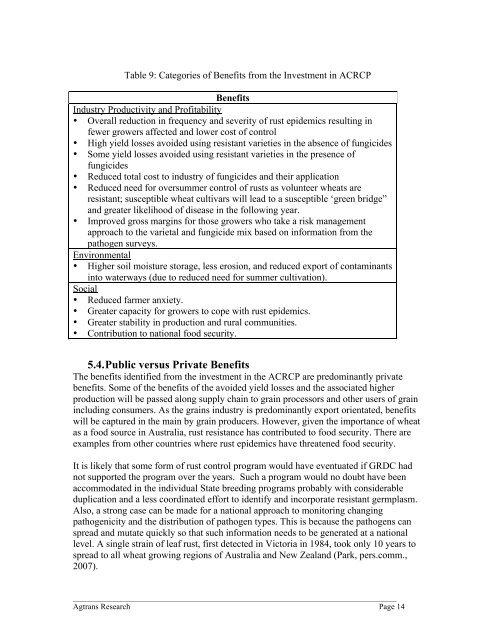An Economic Analysis of GRDC Investment in the - Grains Research ...
An Economic Analysis of GRDC Investment in the - Grains Research ...
An Economic Analysis of GRDC Investment in the - Grains Research ...
Create successful ePaper yourself
Turn your PDF publications into a flip-book with our unique Google optimized e-Paper software.
Table 9: Categories <strong>of</strong> Benefits from <strong>the</strong> <strong>Investment</strong> <strong>in</strong> ACRCP<br />
Benefits<br />
Industry Productivity and Pr<strong>of</strong>itability<br />
• Overall reduction <strong>in</strong> frequency and severity <strong>of</strong> rust epidemics result<strong>in</strong>g <strong>in</strong><br />
fewer growers affected and lower cost <strong>of</strong> control<br />
• High yield losses avoided us<strong>in</strong>g resistant varieties <strong>in</strong> <strong>the</strong> absence <strong>of</strong> fungicides<br />
• Some yield losses avoided us<strong>in</strong>g resistant varieties <strong>in</strong> <strong>the</strong> presence <strong>of</strong><br />
fungicides<br />
• Reduced total cost to <strong>in</strong>dustry <strong>of</strong> fungicides and <strong>the</strong>ir application<br />
• Reduced need for oversummer control <strong>of</strong> rusts as volunteer wheats are<br />
resistant; susceptible wheat cultivars will lead to a susceptible ‘green bridge”<br />
and greater likelihood <strong>of</strong> disease <strong>in</strong> <strong>the</strong> follow<strong>in</strong>g year.<br />
• Improved gross marg<strong>in</strong>s for those growers who take a risk management<br />
approach to <strong>the</strong> varietal and fungicide mix based on <strong>in</strong>formation from <strong>the</strong><br />
pathogen surveys.<br />
Environmental<br />
• Higher soil moisture storage, less erosion, and reduced export <strong>of</strong> contam<strong>in</strong>ants<br />
<strong>in</strong>to waterways (due to reduced need for summer cultivation).<br />
Social<br />
• Reduced farmer anxiety.<br />
• Greater capacity for growers to cope with rust epidemics.<br />
• Greater stability <strong>in</strong> production and rural communities.<br />
• Contribution to national food security.<br />
5.4. Public versus Private Benefits<br />
The benefits identified from <strong>the</strong> <strong>in</strong>vestment <strong>in</strong> <strong>the</strong> ACRCP are predom<strong>in</strong>antly private<br />
benefits. Some <strong>of</strong> <strong>the</strong> benefits <strong>of</strong> <strong>the</strong> avoided yield losses and <strong>the</strong> associated higher<br />
production will be passed along supply cha<strong>in</strong> to gra<strong>in</strong> processors and o<strong>the</strong>r users <strong>of</strong> gra<strong>in</strong><br />
<strong>in</strong>clud<strong>in</strong>g consumers. As <strong>the</strong> gra<strong>in</strong>s <strong>in</strong>dustry is predom<strong>in</strong>antly export orientated, benefits<br />
will be captured <strong>in</strong> <strong>the</strong> ma<strong>in</strong> by gra<strong>in</strong> producers. However, given <strong>the</strong> importance <strong>of</strong> wheat<br />
as a food source <strong>in</strong> Australia, rust resistance has contributed to food security. There are<br />
examples from o<strong>the</strong>r countries where rust epidemics have threatened food security.<br />
It is likely that some form <strong>of</strong> rust control program would have eventuated if <strong>GRDC</strong> had<br />
not supported <strong>the</strong> program over <strong>the</strong> years. Such a program would no doubt have been<br />
accommodated <strong>in</strong> <strong>the</strong> <strong>in</strong>dividual State breed<strong>in</strong>g programs probably with considerable<br />
duplication and a less coord<strong>in</strong>ated effort to identify and <strong>in</strong>corporate resistant germplasm.<br />
Also, a strong case can be made for a national approach to monitor<strong>in</strong>g chang<strong>in</strong>g<br />
pathogenicity and <strong>the</strong> distribution <strong>of</strong> pathogen types. This is because <strong>the</strong> pathogens can<br />
spread and mutate quickly so that such <strong>in</strong>formation needs to be generated at a national<br />
level. A s<strong>in</strong>gle stra<strong>in</strong> <strong>of</strong> leaf rust, first detected <strong>in</strong> Victoria <strong>in</strong> 1984, took only 10 years to<br />
spread to all wheat grow<strong>in</strong>g regions <strong>of</strong> Australia and New Zealand (Park, pers.comm.,<br />
2007).<br />
________________________________________________________________________________<br />
Agtrans <strong>Research</strong> Page 14

















